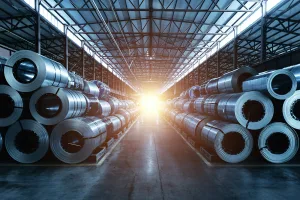How Does Hong Kong’s Steel Market Handle Inventory Management?

Effective inventory management is crucial in the steel market, where demand can fluctuate and supply chain dynamics are complex. In Hong Kong, a major trading hub for steel, efficient inventory control not only helps manufacturers meet market demands but also minimizes costs and enhances competitiveness. This article delves into the key strategies and technologies employed by Hong Kong’s steel industry to master inventory management.
1. The Importance of Inventory Management in the Steel Market
In the steel industry, where raw materials are bulky and often expensive, managing inventory efficiently is essential. The stakes are high; overstocking can tie up capital and lead to increased holding costs, while understocking can result in production delays and lost sales opportunities.
A. Cost Efficiency
Effective inventory management helps steel producers minimize storage costs, reduce waste, and maintain healthy cash flow. By optimizing inventory levels, companies can allocate resources more effectively and invest in other areas of the business.
B. Meeting Market Demand
With construction and manufacturing projects fluctuating in demand, maintaining the right level of inventory ensures that steel suppliers can respond quickly to customer needs without delay. This responsiveness is particularly vital in Hong Kong, where project timelines can be tight.
2. Inventory Management Strategies in Hong Kong’s Steel Market
Hong Kong’s steel industry employs various strategies to optimize inventory management:
A. Just-in-Time (JIT) Inventory System
Many steel companies in Hong Kong utilize the Just-in-Time (JIT) inventory approach. JIT minimizes inventory levels by ordering materials only as needed for production. This method reduces holding costs and enhances cash flow while ensuring that manufacturers can respond to immediate production demands.
B. Demand Forecasting
Accurate demand forecasting is critical for effective inventory management. Hong Kong’s steel producers use historical data and market trends to predict future demand. By analyzing factors such as construction activity, economic indicators, and seasonal trends, companies can adjust their inventory levels accordingly, ensuring they have enough stock to meet upcoming needs without overcommitting resources.
C. Inventory Turnover Ratio Optimization
Monitoring the inventory turnover ratio helps steel companies assess how quickly they are selling their stock. A high turnover ratio indicates efficient inventory management, while a low ratio may signal overstocking or slow sales. Hong Kong’s steel market aims to maintain a healthy balance, ensuring that inventory moves quickly while still meeting customer needs.
3. Technology and Automation in Inventory Management
Advancements in technology have transformed inventory management practices in Hong Kong’s steel industry. Automation and digital tools play a significant role in optimizing inventory control.
A. Inventory Management Software
Many steel companies employ sophisticated inventory management software that provides real-time data on stock levels, order status, and sales forecasts. This software allows manufacturers to track inventory movements, manage suppliers, and analyze trends efficiently.
B. RFID and Barcode Systems
Radio Frequency Identification (RFID) and barcode systems are increasingly used to track inventory accurately. These technologies enable steel producers to monitor stock levels in real-time, improving accuracy in inventory counts and reducing the risk of human error. By automating the tracking process, companies can streamline operations and improve overall efficiency.
C. Predictive Analytics
Predictive analytics tools leverage data from multiple sources to forecast future inventory needs accurately. By analyzing past sales trends, economic indicators, and market conditions, these tools help companies make informed decisions about inventory levels, ensuring they are neither overstocked nor understocked.
4. Collaboration and Communication Across the Supply Chain
Effective inventory management in Hong Kong’s steel market relies heavily on collaboration and communication with suppliers and customers.
A. Supplier Relationships
Strong relationships with suppliers are essential for timely inventory replenishment. By collaborating closely with suppliers, steel manufacturers can ensure that they receive materials when needed, reducing lead times and maintaining production efficiency. Many companies establish long-term contracts with key suppliers to secure favorable pricing and reliable delivery schedules.
B. Customer Communication
Maintaining open lines of communication with customers is equally important. By understanding customer needs and preferences, steel suppliers can better align their inventory levels with market demand. Engaging in regular discussions with clients helps manufacturers anticipate changes in demand and adjust their inventory strategies accordingly.
5. Sustainability in Inventory Management
As sustainability becomes a growing focus in the steel industry, inventory management practices are also evolving to incorporate more environmentally-friendly approaches.
A. Reducing Waste
Efficient inventory management helps minimize waste by ensuring that steel products are used efficiently and effectively. By optimizing stock levels and production processes, companies can reduce excess materials and improve their overall sustainability efforts.
B. Recyclable Materials Management
Many steel companies are incorporating recyclable materials into their inventory management practices. By focusing on using scrap steel and other recycled materials, manufacturers can reduce their reliance on virgin materials and enhance their environmental footprint.
Conclusion
Effective inventory management is vital for the success of Hong Kong’s steel market. By employing strategies such as Just-in-Time inventory, demand forecasting, and leveraging technology, companies can optimize their operations, reduce costs, and meet customer demands efficiently. As the industry continues to evolve, the integration of sustainable practices and advanced technologies will play a crucial role in shaping the future of inventory management in Hong Kong’s steel sector. Through collaboration and innovation, the industry is well-positioned to thrive in an increasingly competitive market.



